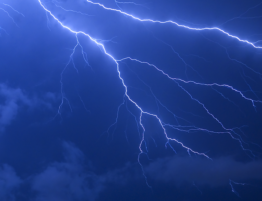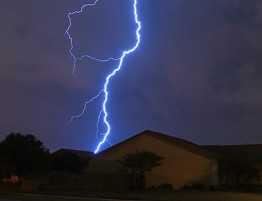
With the incredible increase over the past decade or so of electronic equipment in our lives, the danger of power surges damaging that equipment has become more and more serious. Although power surges are not the only kind of electrical power disturbance, they are the most destructive. Voltage dips, EM interference, and Radio Frequency interference can also disrupt the supply of electrical power to your devices, but power surges, also known as voltage surges, usually have the potential to be the most damaging. Usually a power surge lasts only a millionth of a second and is very minor, but both the duration and the voltage can vary quite a bit, sometimes up to several thousand volts. When this happens, electrical equipment not designed to handle such a high load will usually suffer serious damage.
Homes the United States are generally set up to handle 120-volt, 60 Hz, single phase, alternating current. Alternating current means that the voltage goes up and down in an expected way, usually from 0 to about 169 volts. Appliances and electronics are designed and built to handle this specific kind of electrical power. Those devices that require a DC adaptor convert the alternating current into direct current, but a power surge can still affect them.
If there is a spike of voltage above the expected amount, electronic equipment is often not designed to deal with it. Because there is so much more electrical power flowing into the equipment, the electricity can arc, or jump through the air between contacts or wires. This can generate heat as well as short the circuitry of the equipment. In either case, it will usually damage the electric equipment. Sometimes the damage is so severe that the equipment becomes immediately unusable, but even small bits of damage can accumulate over time. Although the equipment will seem to work normally, repeated surges can have accumulative effects until it finally stops working.
Power surges occur whenever large amounts of electricity have to be suddenly redistributed in the system. This can happen within a home, for example when a large appliance like a refrigerator switches on. The sudden demand for more electricity forces the system to redirect electricity, which can often cause power surges. Sometimes the city power grid may have to suddenly redirect large amounts of power, either because of sudden demand or because of lightning strikes. In these cases, the power going to individual homes may surge to some degree as the system attempts to handle the load. Of course if lightning strikes the home directly, this can introduce quite a bit of electrical power suddenly and catastrophically into the home’s wiring system.
Luckily for our modern electronic culture, there are many ways to protect our equipment and devices from power surges. Individual surge suppressors at the outlet can help protect individual pieces of equipment, such as computers or stereos. On the other hand, you can also install whole-house surge protection. Both options are available through All Day Air Cooling and Heating, and might be helpful to include with the installation or upgrading of a new air conditioning system. Be sure to contact All Day Air Cooling and Heating to discuss your options for surge protection: (239) 357-0727.



Write a comment:
You must be logged in to post a comment.